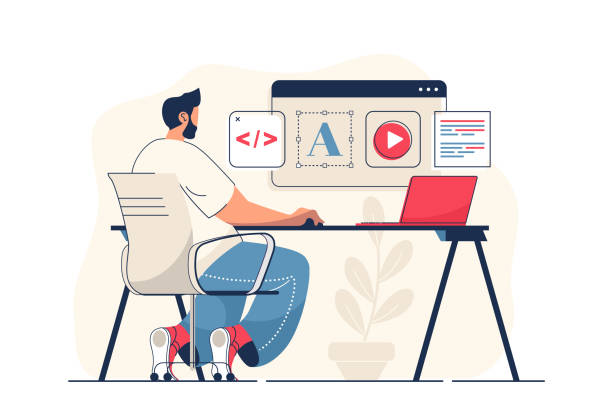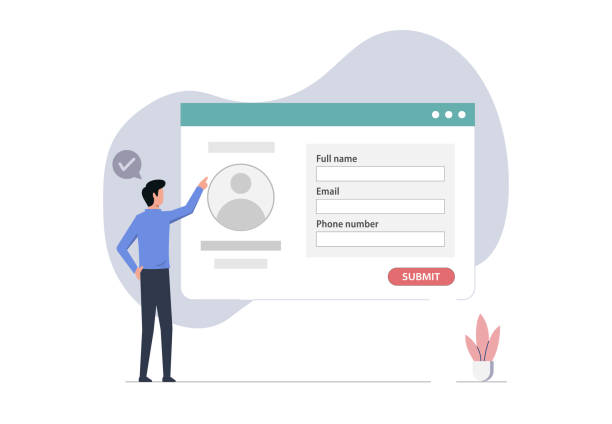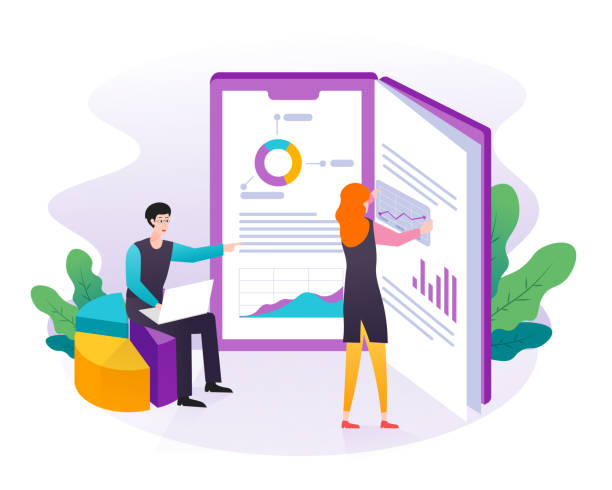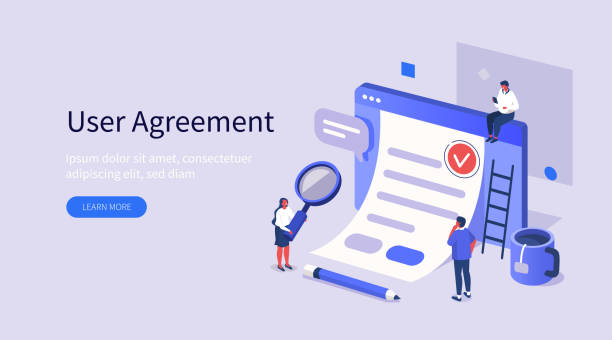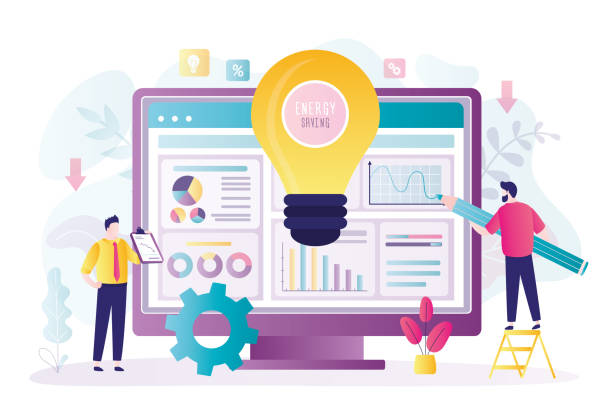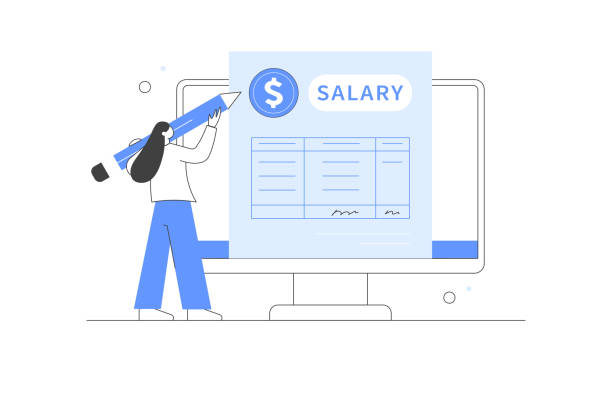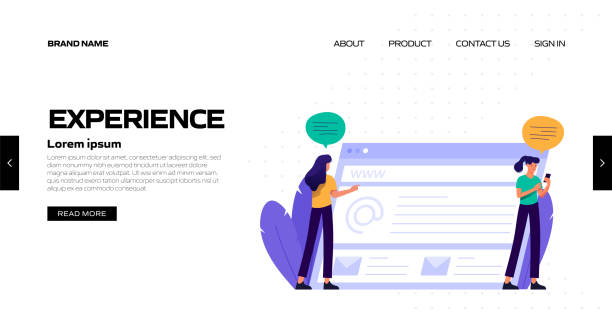Introduction to the Importance of SEO-Optimized Website Design in the Digital Age
In today’s world, where the internet has become the backbone of communication, commerce, and information, having a strong online presence is crucial for any business.
But among billions of existing websites, simply being present is not enough; being seen matters.
This is where the concept of SEO-optimized website design comes in and plays a pivotal role.
#Website_optimization for search engines means structuring, creating content for, and technically optimizing a site in a way that it achieves higher rankings in search engine results like Google, Bing, and Yahoo.
Its main goal is to attract organic (natural) traffic; meaning users who are actively searching for products, services, or information that you offer.
A website designed from the ground up with SEO principles not only has a much greater chance of attracting this valuable traffic but also provides a better user experience.
This multifaceted process includes technical, content, backlinking, and user experience (UX) aspects, all of which together maximize your website’s potential for visibility.
In this article, we will provide a comprehensive explanatory and educational guide on how to achieve this, covering everything from basics to advanced techniques, so you can build a website that is not only visually appealing but also shines in search engines and helps achieve your business goals.
Did you know a weak corporate website loses you many opportunities daily? Solve this problem forever with professional corporate website design by RasawWeb!
✅ Create a powerful and trustworthy brand image
✅ Attract new customers effectively and increase sales
⚡ [Get Free Website Design Consultation]
Key Elements in the Technical Design of an SEO-Optimized Website
SEO-optimized website design begins with its technical aspects; these aspects are the backbone that search engine crawling robots (like Googlebot) rely on to index and understand your website.
One of the most vital factors is website loading speed.
Users who encounter slow site speeds quickly leave, and Google also ranks faster sites higher.
To increase speed, optimizing images (compression and using modern formats like WebP), compressing CSS and JavaScript codes, and using high-speed hosting and CDN (Content Delivery Network) are essential.
URL structure is also of high importance; clean, short, meaningful URLs containing relevant keywords have better readability for users and search engines.
For example, instead of `yoursite.com/page?id=123`, use `yoursite.com/services/web-design-seo`.
Using an SSL certificate and HTTPS protocol is also mandatory, as Google prefers secure websites and trusts them more.
Additionally, having a properly structured XML Sitemap helps robots discover and index all important pages of your site.
Alongside that, the robots.txt file plays a controlling role, telling search engines which sections they can crawl and which they cannot.
A specialized and educational approach to these technical details ensures that the foundation of your site’s SEO is strong, and without these considerations, achieving high rankings will be very difficult.
Content-Driven Strategy in SEO-Optimized Website Design
After laying the technical foundation, it’s time for content, an element rightfully dubbed the “King of SEO.”
For a successful SEO-optimized website design, producing high-quality, relevant, and valuable content is of paramount importance.
This part of the SEO educational topics focuses on in-depth keyword research, writing quality, and content publishing strategies.
The first step is conducting comprehensive keyword research to understand exactly what terms your target audience uses for their searches.
Tools like Google Keyword Planner, Ahrefs, and SEMrush can help you identify high-volume, low-competition keywords with specific user intent (Transactional, Informational, Navigational).
Next, you must produce content that not only naturally and logically incorporates these keywords but also provides real value and comprehensive information to the user.
Your content should be comprehensive, accurate, unique, and of high quality in every respect.
Content length also matters; longer, more in-depth articles that fully cover a topic often rank better and are recognized as authoritative resources.
Using logical headings (H1, H2, H3), short paragraphs, numbered and bulleted lists, and relevant images/videos significantly aids readability and user experience (UX), both of which are crucial factors for SEO.
This section also includes a detailed analysis of content types and their impact on your SEO strategy so you can choose the best content type for your goals.
| Content Type | Description and Use | SEO Benefits and Goals |
|---|---|---|
| Blog Posts | Informational and educational content about topics related to your industry or services. To attract users in the early stages of the buying journey (TOFU). |
High organic traffic attraction through long-tail keywords, increasing brand authority and expertise (E-A-T). |
| Product/Service Pages | Detailed, comprehensive, and persuasive descriptions of products or services, including features, benefits, customer reviews, and high-quality images. | Targeting transactional keywords, increasing Conversion Rate, and direct sales. |
| FAQ Pages | Answers to frequently asked questions by users about products, services, or related topics. Proper structuring with Schema Markup. |
Capturing Featured Snippet and “People Also Ask” spaces in Google, improving user experience with quick and direct answers. |
| Guides & Tutorials | In-depth, step-by-step content to solve user problems or teach specific skills. Usually very comprehensive and lengthy. |
Building outstanding authority and expertise in the relevant field, attracting natural and high-quality backlinks, increasing user dwell time. |
| Infographics & Videos | Engaging visual content that presents complex information in a simple and understandable way. Highly suitable for sharing on social networks. |
Increasing user engagement, improving dwell time, increasing social sharing, and potential for acquiring visual backlinks. |
Click here to preview your posts with PRO themes ››
The Importance of User Experience (UX) in SEO-Optimized Website Design
In recent years, Google has increasingly emphasized the importance of user experience (UX) in ranking websites.
This shift in approach indicates that an SEO-optimized website design is no longer just about optimizing for search robots, but about providing the best and most efficient experience possible for human users.
If users cannot easily navigate your site (complex or illogical navigation), find the content they are looking for, or encounter slow site speeds, they will quickly leave.
These negative user behaviors, such as high Bounce Rate and low Dwell Time, send clear negative signals to search engines that can severely damage your site’s ranking.
Therefore, a website must be user-friendly, responsive (for correct display on different devices and screen sizes), and have an appealing visual design.
Elements such as simple and logical navigation, sufficient use of white space, readable and appropriate fonts, good color contrast, and minimalist visual design can significantly help improve UX.
Also, Call to Action (CTA) buttons should be clear and visible to guide the user towards the next action.
The ultimate goal is for users to feel comfortable on your site, easily achieve their goals, and enjoy their experience, which directly impacts SEO ranking signals.
This is an explanatory topic that encompasses both design aspects and user psychological aspects, ultimately leading to sustainable SEO success.
Are visitors to your e-commerce site leaving before purchasing? Don’t worry anymore! With RasawWeb’s professional e-commerce website design services, solve the problem of not converting visitors into customers forever!
✅ Significant increase in conversion rates and sales
✅ Exceptional and engaging user experience
⚡ Contact us now for a free consultation!
Mobile-First Indexing and Responsive Design in SEO
Given the unprecedented and growing use of mobile phones for internet access, Google has adopted the revolutionary “Mobile-First Indexing” policy.
This means that Google primarily considers the mobile version of your website for indexing and ranking, not its desktop version.
Therefore, an SEO-optimized website design today is almost meaningless and doomed to fail without responsive design and full optimization for mobile devices.
Responsive Design ensures that your website displays correctly and provides a seamless user experience regardless of the device’s screen size (whether a small smartphone, a medium tablet, or a large desktop monitor).
This includes automatically adjusting the size of images, fonts, and page element layouts so that content is always readable and accessible.
Furthermore, mobile loading speed is of particular importance, as mobile users often have less patience, and the bounce rate from slow mobile sites is very high.
Tools like Google PageSpeed Insights and Google’s Mobile-Friendly Test can help you evaluate your site’s mobile performance and identify and resolve issues.
Also, optimizing touch targets like buttons and links for easy use with fingers, and ensuring the absence of Flash content (which is not supported on mobile) are important considerations in mobile-first design.
This aspect of SEO is a relatively new but vital news topic that is rapidly evolving, and every expert in web design and SEO must pay attention to it and prioritize it to prevent a drop in search rankings.
The Importance of Link Building and Off-Page SEO in SEO-Optimized Website Design
Alongside On-Page SEO, which involves optimizing the technical and content aspects of your website, Off-Page SEO also plays a vital and undeniable role in site ranking.
Link Building, especially acquiring high-quality backlinks, is one of the most important factors in Off-Page SEO.
Backlinks (links from other websites to your site) are considered votes of confidence, endorsements, or credibility from other websites for your content and authority.
The more high-quality, relevant backlinks you have from authoritative domains (High Domain Authority), the higher your site’s credibility with Google, and consequently, the better ranking you will achieve in search results.
However, it is important that quality takes precedence over quantity; one backlink from a highly authoritative and relevant site is worth much more than dozens of backlinks from low-authority, irrelevant, or spammy sites.
Link-building strategies should be natural and ethical (White Hat SEO) and include creating shareable and engaging content (Linkable Assets), content marketing, participating in forums and specialized groups, active presence on social media, publishing press releases (Digital PR), and connecting with influential people and reputable bloggers.
Identifying and repairing broken links on other sites that can link back to your site is also an effective technique.
This section of the comprehensive guide for SEO-optimized website design shows you how to create a powerful and natural backlink profile with smart and sustainable strategies.
This is an analytical topic that requires a deep understanding of the web ecosystem and its dynamics to gain online credibility.
Click here to preview your posts with PRO themes ››
Measuring Success and Analytical Tools in SEO-Optimized Website Design
After implementing SEO-optimized website design strategies, it’s time to measure success and analyze performance.
SEO is not a static process, but a continuous and cyclical effort that requires data, accurate statistics, and actionable insights for ongoing optimization.
Tools like Google Analytics and Google Search Console are two essential, free, and indispensable tools that every webmaster should use regularly.
Google Analytics provides comprehensive information about site traffic (number of visitors, pages viewed, time spent), user behavior (navigation path, exit rates), Bounce Rate, and traffic sources (organic search, social networks, referrals).
Google Search Console also helps you view your site’s performance directly in search results, identify page indexing issues (such as crawl errors, blocked pages), check the status of your keywords (impressions, clicks, CTR), and obtain information about your site’s backlinks.
In addition to these free tools, paid and more advanced tools like SEMrush, Ahrefs, and Moz offer broader capabilities for keyword research, competitor analysis, in-depth backlink analysis, and rank tracking.
Regular analysis of this data helps you identify the strengths and weaknesses of your SEO strategy, discover new opportunities, and make data-driven decisions for continuous improvement.
This section is a practical tutorial for better understanding SEO metrics and how to use analytical tools to increase your website’s efficiency.
| Key SEO Metric | Description and Importance | Main Tools for Monitoring |
|---|---|---|
| Organic Traffic | The number of visitors who come to your site through natural search engine results. The most important metric for measuring SEO success. |
Google Analytics, Google Search Console, SEMrush, Ahrefs |
| Keyword Rankings | The position of your site’s pages for specific keywords in search results. Indicates the effectiveness of the keyword strategy. |
Google Search Console, SEMrush, Ahrefs, Moz Pro |
| Bounce Rate | The percentage of users who leave your site after visiting only one page. A high rate indicates a poor user experience. |
Google Analytics |
| Dwell Time/Time on Page | The amount of time a user stays on a page of your site. High dwell time indicates engaging and quality content. |
Google Analytics |
| Click-Through Rate – CTR | The percentage of users who click on your site after seeing it in search results. High CTR indicates an attractive title and meta description. |
Google Search Console |
Common Mistakes in SEO-Optimized Website Design and Ways to Prevent Them
On the path to SEO-optimized website design, there are common mistakes that can nullify your efforts and even seriously damage your site’s ranking.
One of the biggest mistakes is neglecting technical SEO.
Many webmasters focus solely on content and overlook the importance of site speed, URL structure, HTTPS status, or Mobile-Friendliness, which can lead to indexing issues or a poor user experience.
Another very dangerous mistake is the excessive and unnatural use of keywords (Keyword Stuffing), which not only is severely penalized by Google but also drastically reduces readability and user experience.
Keywords should be used naturally, smartly, and with the aim of responding to user needs within the content.
Ignoring the importance of high-quality backlinks and focusing on acquiring spammy links or through Private Blog Networks (PBNs) can also harm site ranking.
Duplicate Content is also a serious problem that can confuse search engines and divide authority among pages.
Lack of regular content updates, inattention to user intent behind keywords, and not using optimized Title Tags and Meta Descriptions are other common mistakes.
Also, neglecting the structure of internal links, which helps transfer authority between site pages, can eliminate SEO opportunities.
This section, presented as thought-provoking content, helps you recognize these common mistakes, avoid them, and proceed with the optimization path with greater confidence.
This practical guidance helps you prevent ranking drops and search engine penalties.
Are you running an e-commerce site, but your sales aren’t what you expected? RasawWeb will solve your problem forever with professional e-commerce website design services!
✅ Significantly increase conversion rates and sales
✅ Exceptional user experience for your customers
⚡ Click here for a free consultation with RasawWeb!
The Future of SEO and Emerging Trends in Website Design
The world of SEO is constantly changing and evolving, and to maintain the position of an SEO-optimized website design in the future, one must keep pace with new trends and adapt to them.
Artificial intelligence and machine learning (such as Google’s RankBrain, BERT, and MUM) play an increasing role in understanding user intent, natural language processing, and content ranking.
These advanced algorithms help Google understand not only keywords but also the meaning behind searches, so your content must be comprehensive, responsive, and relevant to the user’s true intent.
Optimization for Voice Search is also on the rise, as more users are using voice assistants like Google Assistant, Siri, and Alexa for searches.
This type of search is often longer, more conversational, and resembles direct questions, so your content should be designed to directly answer these questions.
Video content has also gained unprecedented popularity, and optimizing videos for SEO (Video SEO) is of high importance (by using precise meta descriptions, tags, and transcripts).
The E-A-T concept (Expertise, Authoritativeness, Trustworthiness) is a criterion that Google heavily considers for evaluating the quality of content and websites, and websites should strive to strengthen these three factors in all their aspects.
Furthermore, the emergence of visual search, the importance of Local SEO and optimization for Google My Business, and personalization of search results are other important trends.
This section is a news and analytical report of the latest advancements and predictions in the field of SEO, which is vital for maintaining the dynamism and long-term success of an SEO-optimized website.
Click here to preview your posts with PRO themes ››
Conclusion and Continuous Optimization for Long-Term Success
Ultimately, it must be emphasized that SEO-optimized website design is not a destination, but a continuous journey and a complex, long-term process that repeats in cycles.
Success in SEO requires a commitment to continuous updates, precise data analysis, and quick adaptation to changes in search engine algorithms.
By adhering to strong technical principles, producing high-quality, relevant, and valuable content, continuously improving user experience (UX), and implementing effective and ethical link-building strategies, you can establish a strong, stable, and competitive online presence.
Always remember that the ultimate goal of SEO is not just to satisfy search engine robots, but more importantly, to fully satisfy your users.
A website that is well-designed, provides useful content, and offers a flawless user experience will naturally be appreciated by search engines and rank high in results.
It is hoped that this explanatory article has been comprehensive, entertaining, and at the same time thoroughly informative, assisting you on the path to SEO-optimized website design and achieving your online goals.
Continuous optimization, performance monitoring, and staying updated with new trends are the keys to achieving and maintaining high rankings in the competitive digital space in the long term.
Frequently Asked Questions
| Question | Answer |
|---|---|
| What is SEO-optimized website design? | Designing a website that is optimized for both users and search engines to achieve higher rankings. This includes adhering to technical, content, and user experience principles. |
| Why is SEO important in website design? | The importance of SEO in website design is due to its role in increasing site visibility in search results, attracting organic traffic, improving user experience, and enhancing brand credibility and user trust. |
| What are the most important elements of SEO-friendly website design? | Responsiveness for mobile, high loading speed, clear navigation structure, correct use of heading tags (H1-H6), image optimization, and quality content. |
| What is the impact of responsiveness (mobile-friendliness) on SEO? | Google uses mobile-first indexing, meaning it prioritizes the mobile version of websites for ranking. Therefore, responsiveness is crucial for SEO. |
| What is the role of site speed in SEO? | Faster websites provide a better user experience, reduce Bounce Rate, and are favored by search engines. Site speed is one of Google’s ranking factors. |
| How to optimize images for SEO? | By compressing image file sizes, using descriptive and relevant file names, and most importantly, writing appropriate and content/keyword-relevant Alt Text. |
| What is the importance of content in SEO-centric design? | High-quality, relevant, and keyword-rich content is crucial for attracting and engaging users, as well as for ranking in search engines. Content is the king of SEO. |
| How does URL structure affect SEO? | Clean, descriptive, short URLs containing keywords help users and search engines better understand page content and appear in search results. |
| What is Schema Markup and what is its role in SEO? | Schema Markup is structured data that helps search engines better understand site content and display it as Rich Snippets in search results, which increases Click-Through Rate (CTR). |
| Should SEO be considered from the beginning of website design? | Yes, it is highly recommended. Integrating SEO principles from the initial phase of website design saves time and cost, and leads to better and more sustainable long-term results. |
And other services of Rasaw Web advertising agency in the field of advertising
Smart Brand Identity: An effective tool for user engagement through precise audience targeting.
Smart Data Analysis: A combination of creativity and technology for online growth through Google Ads management.
Smart Brand Identity: A novel service to increase customer behavior analysis through the use of real data.
Smart Customer Journey Map: Professional optimization for digital branding using custom programming.
Smart UI/UX: A novel service to increase click-through rates through key page optimization.
And over a hundred other services in the field of internet advertising, advertising consultation, and organizational solutions
Internet Advertising | Advertising Strategy | Advertorials
Resources
Important Tips for SEO-Optimized Website Design
Complete SEO Guide for Website Designers
SEO Principles in Website Design
Successful Online Presence with Strong SEO
? Are you ready to transform your business in the digital world? RasawWeb Aferin Digital Marketing Agency, specializing in corporate website design and providing comprehensive online marketing solutions, is here to help you achieve a powerful and influential presence in the web space.
📍 Tehran, Mirdamad Street, next to Bank Markazi, Kazeroun Jonoubi Alley, Ramin Plaque 6

